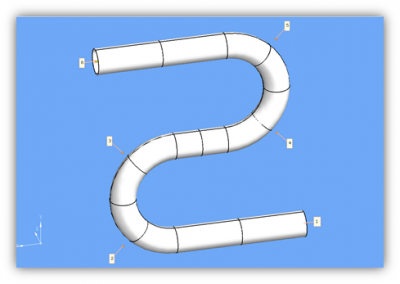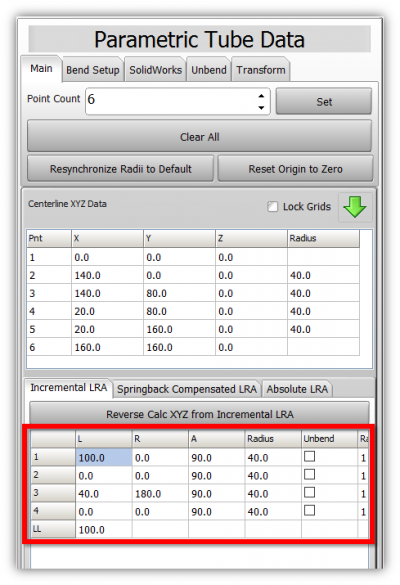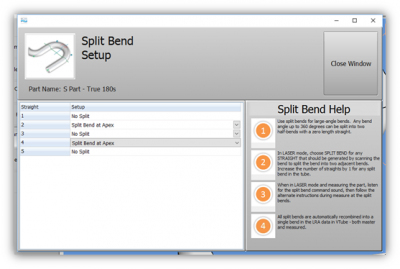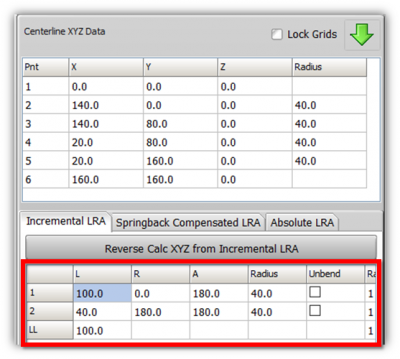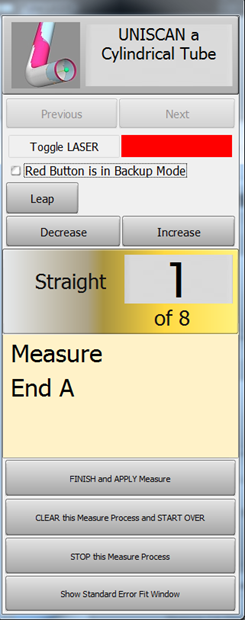Difference between revisions of "VTube-LASER Split Bend Feature"
(→Why Is Split Bend Necessary?) |
(→Why Is Split Bend Necessary?) |
||
| (16 intermediate revisions by one user not shown) | |||
| Line 3: | Line 3: | ||
<td width=225> | <td width=225> | ||
[[image:vtube-laser_logo_1.96.png|200px]] | [[image:vtube-laser_logo_1.96.png|200px]] | ||
| + | <br><br> | ||
* Back to [[VTube-LASER]] | * Back to [[VTube-LASER]] | ||
| + | * Back to [[VTube-LASER v2.9.11]] Update Information | ||
| + | * Back to [[VTube-STEP v2.9.11]] Update Information | ||
| + | |||
| + | <br><br> | ||
</td> | </td> | ||
| Line 14: | Line 19: | ||
__TOC__ | __TOC__ | ||
| − | == About The Split Bend Feature == | + | |
| + | <table> | ||
| + | <tr> | ||
| + | <td> | ||
| + | [[image:LightBulb Over Hand.png|100px]] | ||
| + | </td> | ||
| + | <td> | ||
| + | We invented this feature in 2011. | ||
| + | </td> | ||
| + | </tr> | ||
| + | <tr> | ||
| + | <td> | ||
| + | [[image:winner stand numbers.png|100px]] | ||
| + | </td> | ||
| + | <td> | ||
| + | To the best our knowledge, no other tube measuring system uses this feature. | ||
| + | </td> | ||
| + | </tr> | ||
| + | </table> | ||
| + | |||
| + | == About The Split Bend Measuring Feature == | ||
<table cellpadding=10 width="900"> | <table cellpadding=10 width="900"> | ||
<tr valign=top> | <tr valign=top> | ||
<td width=500 > | <td width=500 > | ||
| − | The Split Bend feature is VTube-LASER's unique method of measuring tubes with 180-degree or greater bends with accuracy. | + | The Split Bend Measuring feature is VTube-LASER's unique method of measuring tubes with 180-degree or greater bends with accuracy. |
<br><br> | <br><br> | ||
| Line 28: | Line 53: | ||
</table> | </table> | ||
| − | == Why Is Split Bend Necessary? == | + | == Why Is Split Bend Measuring Necessary? == |
<table cellpadding=10 width="900"> | <table cellpadding=10 width="900"> | ||
<tr valign=top> | <tr valign=top> | ||
| Line 37: | Line 62: | ||
See the difference between the tubes with the red circles versus the tubes with the blue circles in the illustration. When the bends reach 180 degrees, then each of those bends are given two intersection points.<br><br> | See the difference between the tubes with the red circles versus the tubes with the blue circles in the illustration. When the bends reach 180 degrees, then each of those bends are given two intersection points.<br><br> | ||
At 180-degrees or more, then VTube-LASER must form the single bend '''with two intersection points.'''<br><br> | At 180-degrees or more, then VTube-LASER must form the single bend '''with two intersection points.'''<br><br> | ||
| − | If any bend has the potential to reach and pass 180 degrees in a bender, then VTube-LASER | + | If any bend has the potential to reach and pass 180 degrees in a bender, then VTube-LASER should be setup to use the SPLIT BEND method to measure and solve for the centerline formed between the two intersection points in the 180-degree (or greater) bend. |
</td> | </td> | ||
<td> | <td> | ||
| Line 45: | Line 70: | ||
</table> | </table> | ||
| − | ==Configuring for Split Bend== | + | ==Configuring for Split Bend Measuring== |
<table cellpadding=10 width="900"> | <table cellpadding=10 width="900"> | ||
<tr valign=top> | <tr valign=top> | ||
| Line 95: | Line 120: | ||
</table> | </table> | ||
| − | ==Split Bend Measuring== | + | ==What Happens During Split Bend Measuring== |
<table cellpadding=10 width="900"> | <table cellpadding=10 width="900"> | ||
<tr valign=top> | <tr valign=top> | ||
| Line 108: | Line 133: | ||
</td> | </td> | ||
<td width=400 > | <td width=400 > | ||
| − | [[image:vtube-laser-v2.2_measureguide_cylindricaltube.png]]<br> | + | [[image:vtube-laser-v2.2_measureguide_cylindricaltube.png]]<br><br> |
| + | [[image:vtube-splitbend_construction_geometry.png|500px]]. | ||
</td> | </td> | ||
</tr> | </tr> | ||
| Line 117: | Line 143: | ||
==Other Pages== | ==Other Pages== | ||
* Back to [[VTube-LASER]] | * Back to [[VTube-LASER]] | ||
| − | * | + | * Back to [[VTube-LASER v2.9.11]] Update Information |
| − | * | + | * Back to [[VTube-STEP v2.9.11]] Update Information |
Latest revision as of 04:21, 17 August 2018
|
Contents |
|
We invented this feature in 2011. |
|
|
To the best our knowledge, no other tube measuring system uses this feature. |
About The Split Bend Measuring Feature
|
The Split Bend Measuring feature is VTube-LASER's unique method of measuring tubes with 180-degree or greater bends with accuracy.
|
Why Is Split Bend Measuring Necessary?
|
We invented Split Bend to solve a legacy measuring issue in the tube fabrication.
|
Configuring for Split Bend Measuring
|
Split Bend setup is controlled in the Bend Setup tab of the Master Tube menu in VTube-LASER, and in the Bend Setup tab in VTube-STEP. Both modes of VTube allow you to configure Split Bends. |
|
|
In the Split Bend window, set any straight that will be treated as a Split Bend. See Video 54 for how to setup for a Split Bend. |
Split Bend LRA Compression
What Happens During Split Bend Measuring
|
During tube measurement, when you arrive at the split bend to scan, VTube-LASER will make a special sound and tell you to scan the OUTSIDE of the bend. Scan as much data as you want up to 250 stripes (250 is the default maximum stripe count value). The goal is to be sure that at least one point in one of the stripes touches the highest point of the outside of the bend. So you can take as many stripes of data as you want - VTube will take them all in without a problem.
|
Other Pages
- Back to VTube-LASER
- Back to VTube-LASER v2.9.11 Update Information
- Back to VTube-STEP v2.9.11 Update Information








